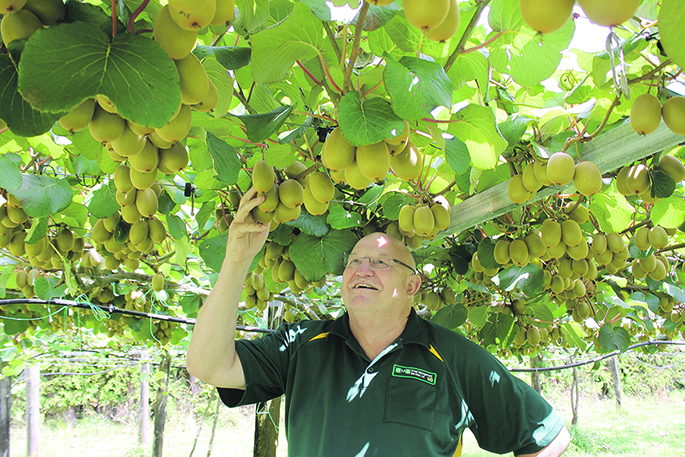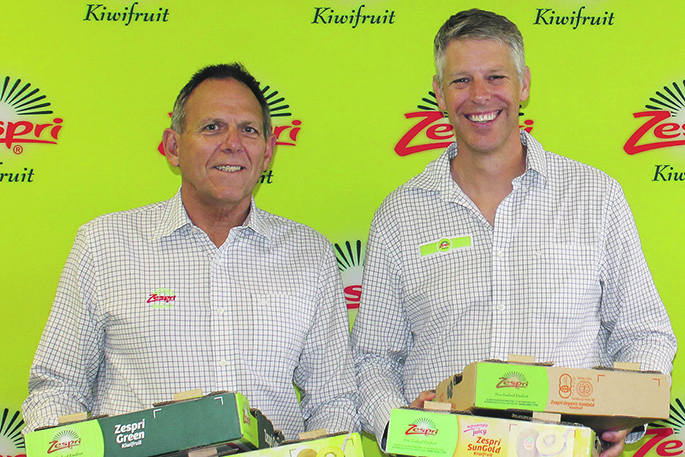It was a completely new word, with no meaning in any language, but the fortunes of an entire industry rested on its success. The sceptics thought it couldn’t be done, but those who believed it could proved them wrong.
Twenty years on, Zespri is one of the most recognisable brand names in the international fruit market and the company bearing the same name leads a highly successful industry.
Zespri collaborative marketing manager Warren Young and Zespri CEO Lain Jager with Zespri But in 1997 when the name Zespri was launched, it caused an uproar. Talkback radio went wild with comments; newspaper editors and cartoonists had a field day. Most wrongly supposed the industry was re-naming ‘kiwifruit’ and failed to grasp the concept that Zespri was the name for the New Zealand brand of kiwifruit, not kiwifruit in general. When the directors of the New Zealand Kiwifruit Marketing Board selected the word ‘Zespri’ from a number of possibilities, the industry was recovering from financial and political turmoil. Peter Berry, who served on the New Zealand Kiwifruit Authority Board from 1985 to 1987 and on NZKMB from 1992 to 1996, well remembers the discussions around the board table over which of the brand names to choose. Not offensive “We had employed an international company to research potential names. They put forward nine and Zespri was the one that appealed most to the board members. It had to be checked to ensure it didn’t mean anything offensive in other languages.” The events which led to the new brand began much earlier. In 1987 competition between exporters had become intense with undercutting and price bargaining onshore and in the markets. This coincided with a massive 4.6 million tray crop. The result was a drastic drop in grower returns and confidence. The NZKA, after much heated industry debate and consultation, proposed to dissolve itself, to end licensed exporters, and introduce a new single desk marketing organisation that had sole rights to buy and market New Zealand kiwifruit. “Not everyone, especially the exporters, were in favour,” says Warren Young, who has been involved in the kiwifruit industry for decades, first working for an exporter and then the NZKMB and is today Zespri’s collaborative marketing manager. Silent majority “But many growers came from the dairy and drystock industries and understood how producer boards worked. The referendum on the issue was a victory for the silent majority because growers gave a mandate for the changes,” In 1988 the New Zealand Kiwifruit Marketing Board was established and faced even more turbulent times. NZKMB chairman John Palmer described the 1992/1993 season as “the most difficult in the board’s short history and a financial disaster”. The board had a trading loss of $740 million and had overpaid growers. In addition, trade creditors and coolstores were owed $18 million. The board, under John’s leadership, negotiated with bankers in an effort to save the industry and growers from bankruptcy. However, many growers went to the wall and an estimated 18 to 20 per cent quit their land. By 1994 John was reporting a “mood of cautious optimism” and transformation as the debt burden eased significantly. Doug Voss, today a Zespri organic kiwifruit grower, was the first chairman of the Zespri Group Ltd in 2000. Grower owned Doug Voss served on the New Zealand Kiwifruit Authority Board from 1988 to 1991, was deputy chairman 1994 to 1997 and chairman in 1999, becoming the first chairman of the Zespri Group Ltd in 2000, a position he held until 2003. He takes considerable satisfaction that the industry is grower-owned and the part he played in helping that happen. On April 1, 2000, kiwifruit growers became the official owners of Zespri Group Ltd, the single biggest kiwifruit marketer in the world and global category leader. “This industry was built on growers’ indomitable spirit, a self-help attitude and determination to overcome the odds and save ourselves from what has sometimes seemed like certain death,” Doug said at the time. Optimism was high, the new variety Zespri Gold (Hort16A) was launched and plans for year-round marketing were in place. “There were times when it was tough, but we were surrounded by good people who shared the workload and had the good of the entire industry firmly at heart.” Bold moves Without the bold moves taken in the 1990s, including the single point of entry marketing and the Zespri brand, Doug believes the industry would not be in the strong position it is today. Another who was intensely involved in the branding process was communications manager Susan Robinson-Derus. Twenty years on, and no longer directly involved with the industry, she’s still passionate about New Zealand kiwifruit, the Zespri brand and kiwifruit growers. “It was just a name to begin with and it needed to become a brand into which people put meaning.” With a limited budget and resources, the Zespri marketing teams on and offshore began campaigns to raise the profile of Zespri Kiwifruit. That included using brightly painted ‘Zespri’ VWs in Europe and young people on roller blades in supermarkets in Japan. Susan is full of admiration for the board members and growers who were brave enough to back the brand, and delighted at the ownership they took in it. America’s Cup “We didn’t have a budget to be a sponsor of the 2000 America’s Cup challenge in New Zealand, but we offered street theatre, with people giving samples of kiwifruit, and the appearance of our big kiwifruit mascot. We asked growers if they would like to wear the costume, which was hot and uncomfortable, and the response was so strong we had to start a roster.” Today the name-with-no-meaning has done more than gain profile and premiums for the fruit which carries its label. It is associated in the minds of consumers with health, vitality, nutrition, fun and safe food – and they are prepared to pay more for a Zespri kiwifruit than those of its competition. For the industry in New Zealand, the brand has also become a focus for unity, a factor which helped with the recovery from the impacts of the vine disease Psa-V.



0 Comments
Leave a Comment